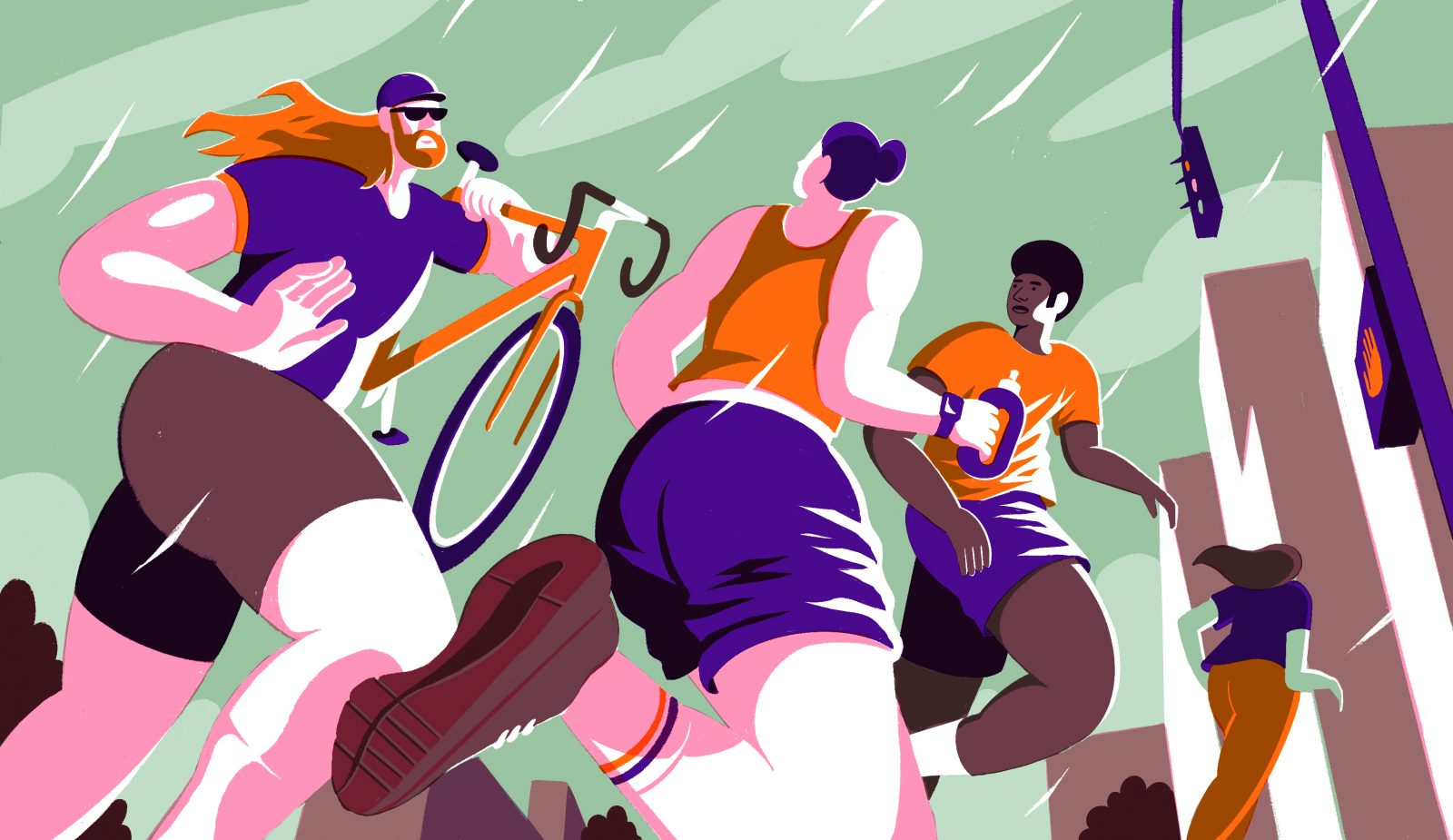Will running add strength and speed to your cycling or just undermine your performance on the bike? Cyclist finds out

Words MICHAEL DONLEVY Illustration TILL LUKAT
It turns out that pedalling a bike isn’t the only thing you can do with your legs. There’s also this thing called running. But should we be doing it?
There are two answers to this, says Hunter Allen, former pro cyclist, owner of The Peaks Coaching Group and cofounder of TrainingPeaks: if you like running, yes; if you don’t like running, no. Let’s get the negatives out of the way first. ‘If you force yourself to go running it will just make you hate it more,’ says Allen. ‘If you want to train off the bike, chose another aerobic sport that you like better. Swimming? Roller blading?’
Let’s say you’re a cyclist who enjoys running, but perhaps not to the degree where you want to enter a duathlon (or triathlon if you’re crazy and also like swimming). Should you run as well?
This is a matter of timing. ‘If you enjoy running and you’re in the “off-season”, do some running as part of your cross training,’ says Allen. ‘It will create different stresses on the bones and muscles and will keep stimulating your body to improve. During the riding season, if you’re focussed on improving your cycling, then don’t. Running will make you a slower cyclist.’ Triathlon coach Simon Ward agrees. ‘Will running enhance your preparation for a race, sportive or personal goal? If it won’t, don’t beat yourself up about not doing it. Training should be specific, and there are better ways to spend your time than running, for example with some strength training or mobility work.’
What about in winter, when people tend to focus on ‘base fitness’? What are the pros of running during these months?
‘There are a number of good reasons to run,’ says cycling coach Ric Stern. ‘One is time – it’s much easier to fit in a 30-minute run than it is a bike ride because there’s less kit to change into and no bike to check first or clean afterwards. Plus it’s good to get outdoors in the winter when you may be put off riding in the cold.’ There’s no question that running is one of the most effective ways of building cardiovascular fitness, and in this sense it’s also time-effective. ‘A 30-minute run feels like more work than a 30-minute bike ride,’ says Stern. ‘It’s really good for your heart and, as a bonus, running helps prevent osteoporosis – unlike cycling, which can cause it.’
Are there any risks to taking up running
as a complement to cycling?
There are some cons to running, the biggest of which is the threat of injury. ‘I’ve had two cyclists start running, overdo it and blow out their ACLs [anterior cruciate ligament] so they had to have surgery,’ says Allen. ‘Start really slow and build up carefully. And if you have pain, stop.’ There’s also the fact that, even during the off-season, running could potentially harm your cycling. ‘It slows down your leg speed and makes your leg muscles tired in a different way to cycling,’ Allen adds. ‘Form is important. Many people bounce up and down instead of moving laterally. Let your body fall forward and then get your feet and legs out in front of you.’
Let’s say you have time for one run a week. What’s the best sort of session to do?
‘That depends on your goal,’ says Allen. ‘If it’s for something different to do, a strong tempo-paced run would be fine. If you’re running because you are travelling and can’t ride, do intervals, just like you would on the bike. A word of warning, though. ‘It’s very hard to make running a recovery day. You’d be better off to spin on the bike for an hour or just take the day off.’ ‘That’s mainly due to the greater mechanical destruction forces involved in running,’ Stern agrees. ‘If you want a recovery day, I’d suggest doing it on the bike, and I suggest this for duathletes and triathletes as well.’ The key here is balance. ‘A couple of easy sessions each week are fine if you have the time, but I’d save any highintensity workouts for on the bike,’ says Ward. ‘Think about where you’re going to run as well. Running on the trails can have tremendous mental health benefits, and off-road will also limit the post-run muscle soreness and create less fatigue.’ Stern takes a slightly different view. ‘If you really can’t face cycling in the winter – due to crappy roads, mud, bad driving or wanting to avoid the indoor trainer – one endurance run and one higherintensity run per week could be ideal.’ The best thing to do is experiment and see what works for you, so long as you bear in mind Allen’s advice to start slowly and stop immediately if you feel any discomfort.
Why do we hear about the ‘runner’s high’, but never the ‘cyclist’s high’?
It’s just terminology. The ‘runner’s high’ refers to the release of feel-good endorphins in the brain that give you a warm glow after a hard workout, but it can just as easily be applied to cycling if you do it right. ‘Go out and do a hard interval session, where you do 4 x 10 minutes at your FTP [the maximum pace you can sustain for one hour] and push it,’ says Allen. ‘Suffer a bit on the bike.’
What are good sessions to combine my cycling with some running?
Try brick sessions, where you mix disciplines, so for example you would ride and then go straight into a run. ‘Brick training can help with overall fitness, but think about your goals,’ says Allen. ‘If your main goal is to be a faster cyclist, focus on cycling and do some running in the off-season. If you love both, dabble in each and you’ll be enjoying those endorphins times two.’


